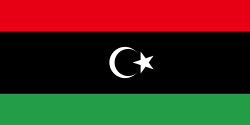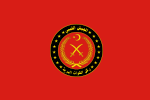Search results
Appearance
There is a page named "Libyan Armed Forces" on Wikipedia
- The Libyan Armed Forces (Arabic: القوات المسلحة الليبية) or the Libyan Arab Armed Forces (Arabic: القوات المسلحة العربية الليبية) are, in principle, the...23 KB (2,371 words) - 19:17, 3 April 2025
- The Armed Forces of the Libyan Arab Jamahiriya (Arabic: القوات المسلحة للجماهيرية العربية الليبية) consisted of the Libyan Army, Libyan Air Force and...28 KB (3,176 words) - 12:33, 4 April 2025
- officially the National Liberation Armed Forces of the Free Libyan Republic, formerly known as the Free Libyan Army, was a Libyan military organisation affiliated...57 KB (4,877 words) - 06:16, 7 March 2025
- The Libyan National Army (LNA; Arabic: الجيش الوطني الليبي, al-jaysh al-waṭaniyy al-Lībii) or the Libyan Arab Army (LAA; Arabic: الجيش العربي الليبي, al-Jaysh...74 KB (4,462 words) - 19:45, 27 March 2025
- as a symbol of the reborn Libyan armed forces. The Libyan Special Forces Brigade reportedly has had frictions with the Libya Shield Force, a government-sanctioned...12 KB (988 words) - 03:53, 30 October 2024
- The Libyan Army (Arabic: الجيش الليبي) is the brand for a number of separate military forces in Libya, which were under the command of the internationally...48 KB (2,592 words) - 21:34, 9 February 2025
- From 1969 to 1977, the name was the Libyan Arab Republic. In 1977, the name was changed to Socialist People's Libyan Arab Jamahiriya. Jamahiriya was a term...127 KB (12,911 words) - 23:19, 7 April 2025
- The Libyan civil war, also known as the First Libyan Civil War, was an armed conflict in 2011 in the North African country of Libya that was fought between...256 KB (22,583 words) - 22:55, 6 April 2025
- The Libyan crisis is the current humanitarian crisis and political-military instability occurring in Libya, beginning with the Arab Spring protests of...51 KB (4,382 words) - 21:57, 7 April 2025
- The Libyan Navy (Arabic: قوات البحرية الليبية) is the naval warfare branch of the Libyan Armed Forces. Established in November 1962, Libyan Navy was headed...22 KB (1,930 words) - 21:58, 11 December 2024
- The Qatar Armed Forces (Arabic: القوات المسلحة القطرية, romanized: Al-Quwwat Al-Musallahah Al-Qatariyyah) are the military forces of the State of Qatar...22 KB (2,112 words) - 13:38, 10 March 2025
- their Libyan allies in the latter part of 1986. Many of them were subsequently integrated into the national army, the Chadian National Armed Forces (FANT)...2 KB (167 words) - 17:09, 16 December 2023
- of Libya and the Libyan state". These opposition forces included organized and armed militia groups, participants in the Libyan Civil War, Libyan diplomats...11 KB (932 words) - 17:24, 13 March 2025
- served as Libya's de facto head of state as Revolutionary Chairman of the Libyan Arab Republic and commander-in-chief of the armed forces. It was ideologically...17 KB (1,684 words) - 06:13, 10 January 2025
- head of the Libyan ministry of defence and is responsible for the Libyan Armed Forces. Salem el Kebti, "Libia..Maseerat al Istiqlal…Watha'iq Mahalliya...13 KB (313 words) - 04:43, 13 December 2024
- The Libyan Army (Arabic: الجيش الليبي) was the branch of the Armed Forces of the Libyan Arab Jamahiriya, the Libyan Arab Republic and the Kingdom of Libya...37 KB (2,731 words) - 12:36, 4 April 2025
- Military ranks of Libya are the military insignia used by the Libyan Armed Forces. The rank insignia was inspired by the armed forces of the United Kingdom...3 KB (188 words) - 08:43, 22 October 2024
- The Chadian–Libyan War was a series of military campaigns in Chad between 1978 and 1987, fought between Libyan and allied Chadian forces against Chadian...67 KB (8,677 words) - 18:20, 16 March 2025
- Nasserist officers in the Libyan Army, which overthrew the Senussi monarchy of King Idris I and resulted in the formation of the Libyan Arab Republic. The Free...25 KB (2,436 words) - 05:25, 14 March 2025
- The Libyan civil war (2014–2020), also known as the Second Libyan Civil War, was a multilateral civil war which was fought in Libya among a number of...216 KB (19,959 words) - 21:04, 2 April 2025
- (1970-87), $242 million Currency: Libyan dinar (plural—dinars); 1 Libyan dinar (LD) = 1,000 dirhams Exchange rates: Libyan dinars (LD) per US$1—0.2896 (January
- States Armed Forces are the national military forces of the United States of America, a country in the continent of North America.The United States Armed Forces
- forces managed to take control of certain areas of eastern Libya. The situation escalated into an armed conflict between opposition forces and forces















